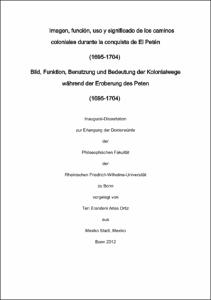Imagen, función, uso y significado de los caminos coloniales durante la conquista de El Petén (1695-1704) = Bild, Funktion, Benutzung und Bedeutung der Kolonialwege während der Eroberung des Peten (1695-1704)

Imagen, función, uso y significado de los caminos coloniales durante la conquista de El Petén (1695-1704) = Bild, Funktion, Benutzung und Bedeutung der Kolonialwege während der Eroberung des Peten (1695-1704)

| dc.contributor.advisor | Grube, Nikolai | |
| dc.contributor.author | Arias Ortiz, Teri Erandeni | |
| dc.date.accessioned | 2020-04-17T18:05:53Z | |
| dc.date.available | 2020-04-17T18:05:53Z | |
| dc.date.issued | 18.10.2012 | |
| dc.identifier.uri | https://hdl.handle.net/20.500.11811/5236 | |
| dc.description.abstract | En 1697 el Gobernador interín de la Provincia de Yucatán, Martín de Ursúa y Arizmendi, anunció el término de la apertura del Camino Real entre Campeche y el Petén Itzá, y daba por conquistado el último señorío de mayas independientes. Lo cierto es que El Petén, región ubicada en la parte central del área maya, representaba una zona de particular interés, principalmente porque fue el lugar hacia donde los mayas huían para no ser convertidos, era el lugar de refugio e independencia. Pero ante los ojos de los españoles significó la más ardua tarea para controlar una región, lo cual en realidad nunca lograron. Partiendo de los conceptos de imagen, uso, significado y función, se llevó a cabo un análisis etnohistórico de los caminos coloniales de El Petén (1695-1704). Dicha tarea se basó, especialmente, en la recopilación, análisis y clasificación de un gran número de documentos coloniales, en su mayoría provenientes del Archivo General de Indias. En base a lo anterior fue posible concluir que las funciones de los caminos no sólo estuvieron ligadas a la mera movilidad y el desarrollo de la región y sus consecuencias, sino también a la imagen que mayas y españoles tenían de la zona, lo cual fue crucial para la historia de El Petén. Los españoles nunca pudieron controlar totalmente las montañas (El Petén). Se deduce que este fracaso se debió a que ellos nunca tuvieron la idea de la geografía de El Petén. En su mente la imagen de las montañas nunca estuvo bien clara e integrada, sin lo cual no fue posible hacer de las montañas un territorio legible. Fue posible entonces, proponer una serie de diferencias entre los caminos antes y después de la conquista, así como una clasificación (formal e informal) y las distintas funciones que éstos tuvieron. | en |
| dc.description.abstract | Image, function, use and meaning of the colonial roads during the conquest of El Petén (1695-1704) In 1697 the Governor of the Province of Yucatan, Martín de Ursúa y Arizmendi, announced that the construction of the Camino Real between Campeche und El Petén Itzá was completed and with this the conquest of the last independent Maya kingdom. Actually El Petén, located in the central part of the Maya Area, represented an important zone because it was principally the place to where Mayas fled from conversion. It was the place of refuge and independence. The Spanish conquerors never really succeeded in controlling that area. Starting from the concepts of image, use, meaning and function, it was possible to conduct an ethnohistorical analysis of colonial roads at El Petén (1695-1704). This work was specially based on recompilation, analysis and classification of a large number of colonial documents, the majority from the General Archive of the Indies. Based on the said above, it was possible to conclude that the road functions’ were not only linked to mobility and development of the region, but to the image that Mayas and Spaniards had about the region, which was crucial for the history of El Petén. The Spaniards could never control the “montañas” (El Petén). It is deduced that this failure was due to their lack of conception on El Petén’s geography. In their mind the “montañas’” image was never clear or integrated. Without this it was not possible to transform this region into a legible territory. Finally, it was possible to propose a series of differences between the roads before and after the conquest, as well as a classification (formal and informal) and a list of their different functions. | en |
| dc.language.iso | spa | |
| dc.rights | In Copyright | |
| dc.rights.uri | http://rightsstatements.org/vocab/InC/1.0/ | |
| dc.subject | Ethnohistorie | |
| dc.subject | Kolonialwege | |
| dc.subject | Eroberung | |
| dc.subject | Maya-Gebiet | |
| dc.subject | Bildbegriff | |
| dc.subject | Ethnohistory | |
| dc.subject | colonial roads | |
| dc.subject | conquest | |
| dc.subject | Maya Area | |
| dc.subject | image | |
| dc.subject.ddc | 390 Bräuche, Etikette, Folklore | |
| dc.title | Imagen, función, uso y significado de los caminos coloniales durante la conquista de El Petén (1695-1704) = Bild, Funktion, Benutzung und Bedeutung der Kolonialwege während der Eroberung des Peten (1695-1704) | |
| dc.type | Dissertation oder Habilitation | |
| dc.publisher.name | Universitäts- und Landesbibliothek Bonn | |
| dc.publisher.location | Bonn | |
| dc.rights.accessRights | openAccess | |
| dc.identifier.urn | https://nbn-resolving.org/urn:nbn:de:hbz:5-30074 | |
| ulbbn.pubtype | Erstveröffentlichung | |
| ulbbnediss.affiliation.name | Rheinische Friedrich-Wilhelms-Universität Bonn | |
| ulbbnediss.affiliation.location | Bonn | |
| ulbbnediss.thesis.level | Dissertation | |
| ulbbnediss.dissID | 3007 | |
| ulbbnediss.date.accepted | 16.04.2012 | |
| ulbbnediss.institute | Philosophische Fakultät : Institut für Archäologie und Kulturanthropologie (IAK) | |
| ulbbnediss.fakultaet | Philosophische Fakultät | |
| dc.contributor.coReferee | Vargas Pacheco, Ernesto |
Dateien zu dieser Ressource
Das Dokument erscheint in:
-
E-Dissertationen (698)




